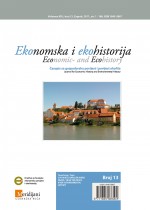GRAND CAYMAN ENVIRONMENTAL HISTORY: A CASE STUDY OF THE ANTHROPOCENE
GRAND CAYMAN ENVIRONMENTAL HISTORY: A CASE STUDY OF THE ANTHROPOCENE
Author(s): J. Donald HughesSubject(s): Geography, Regional studies, Energy and Environmental Studies, Physical Geopgraphy, Historical Geography, Environmental Geography, Human Ecology
Published by: Društvo za hrvatsku ekonomsku povijest i ekohistoriju - Izdavačka kuća Meridijani
Keywords: Anthropocene; capitalism; Caribbean; environmental history; extinction; Grand Cayman Island; Great Acceleration; sea turtles;
Summary/Abstract: The Anthropocene is the idea that human actions have become such a powerful force in the transformation and control of the rest of nature as to leave traces in the natural environment that will persist into future ages, justifying the designation of a new epoch in geological and environmental history. Among conflicting theories as to when the Anthropocene began, important support exists for the »Great Acceleration« of many factors after the Second World War. As a case study, the small and relatively isolated Grand Cayman Island allows scholars to see transformations that are rapid and can be traced to specific causes. There were no native human inhabitants, establishing a baseline in that the island was in a natural state until residents came in the seventeenth century. In the 1960s, after separation from Jamaica, legislation exempting business from taxes was enacted, making the Caymans a notable tax haven and encouraging economic growth. Capitalism and the world market economy played a major role in establishing human formation and control of nature in Grand Cayman Island. Population increased rapidly and tourism became a leading form of development. The Anthropocene does not mean total human control of nature. Hurricanes, earthquakes, and rising sea level are realistic threats to Grand Cayman Island. A number of endemic plants and animals evolved on the island, but a large percentage of these species, and indeed ecosystems, are now threatened with extinction due to human activities including introduction of aggressive species. Programs have been undertaken to protect and restore native species such as sea turtles and the blue iguana, and to designate protected areas. Measures to combat mosquitoes have succeeded. The future of Grand Cayman Island with continued capitalistic development could make it a Caribbean Hong Kong, but nature could intervene.
Journal: Ekonomska i ekohistorija - Časopis za gospodarsku povijest i povijest okoliša
- Issue Year: 2017
- Issue No: 13
- Page Range: 88-95
- Page Count: 8
- Language: English

